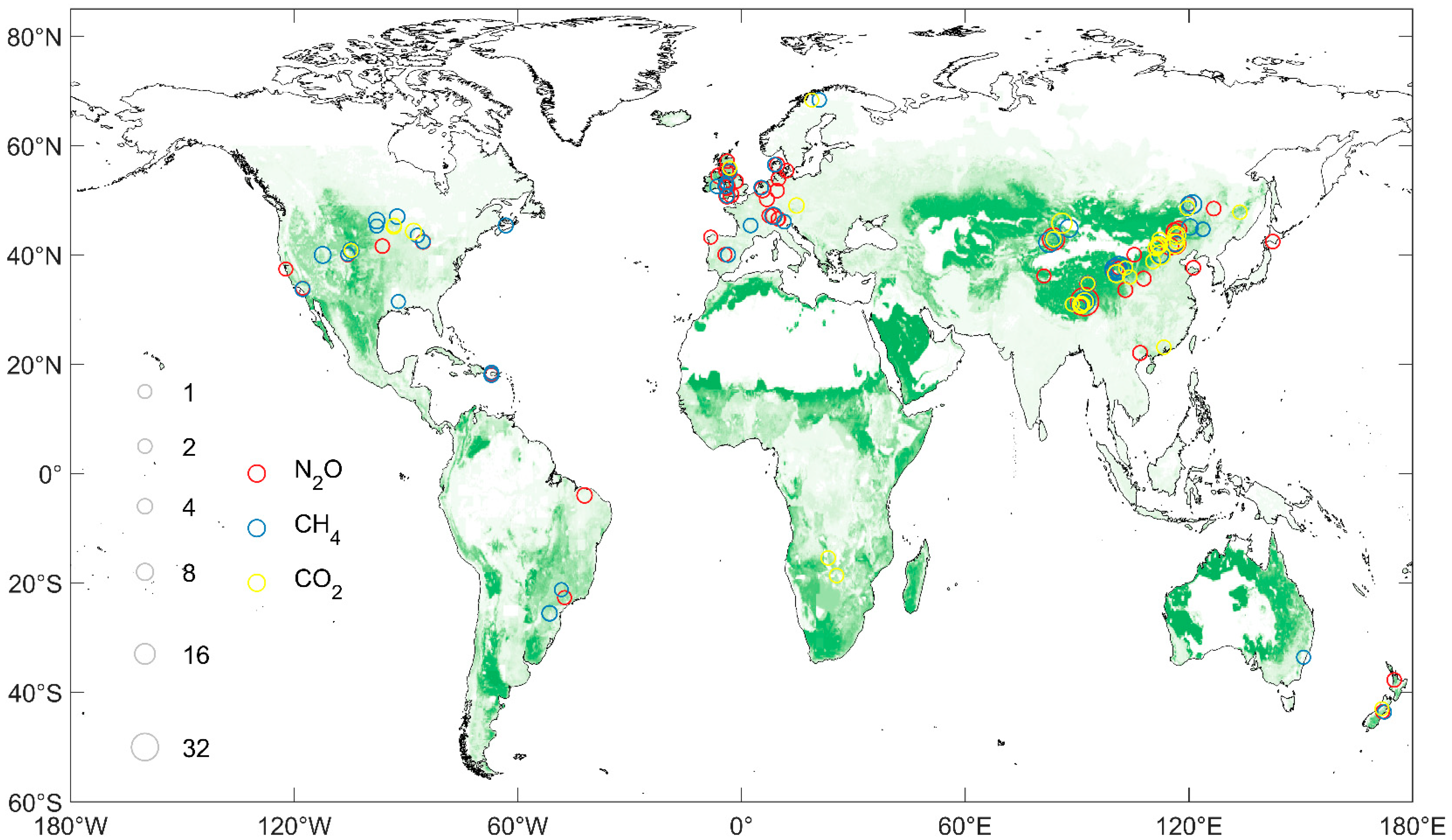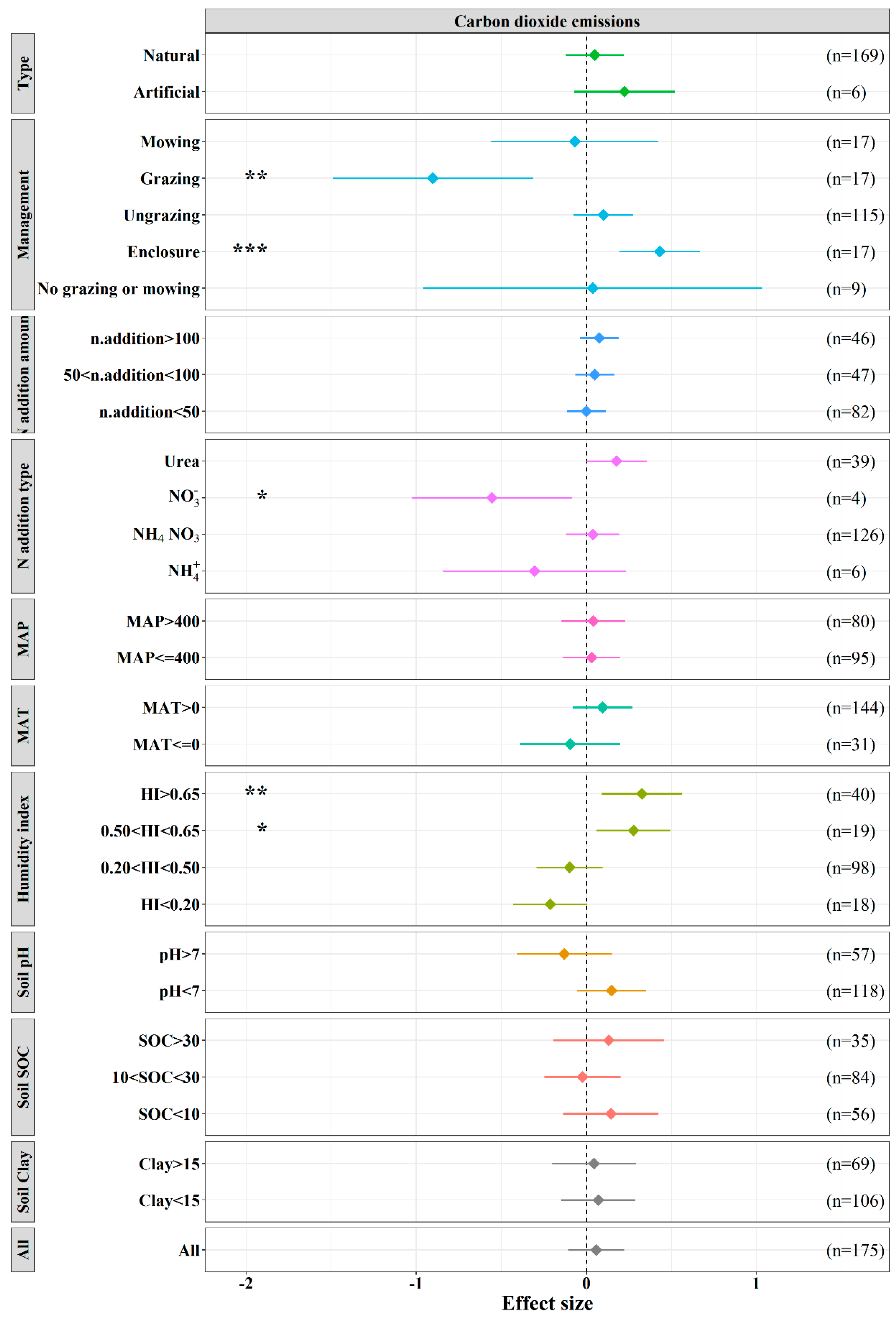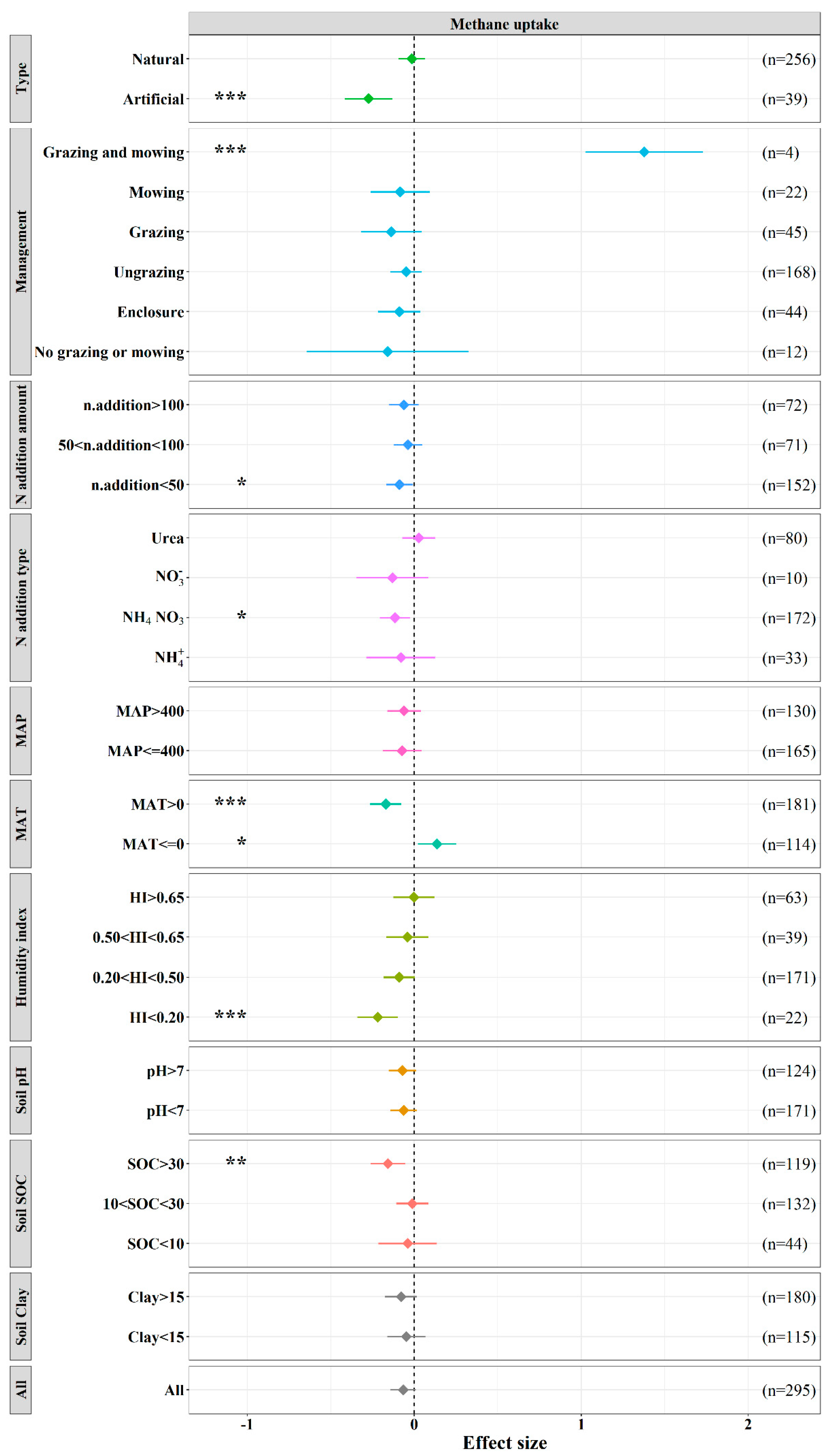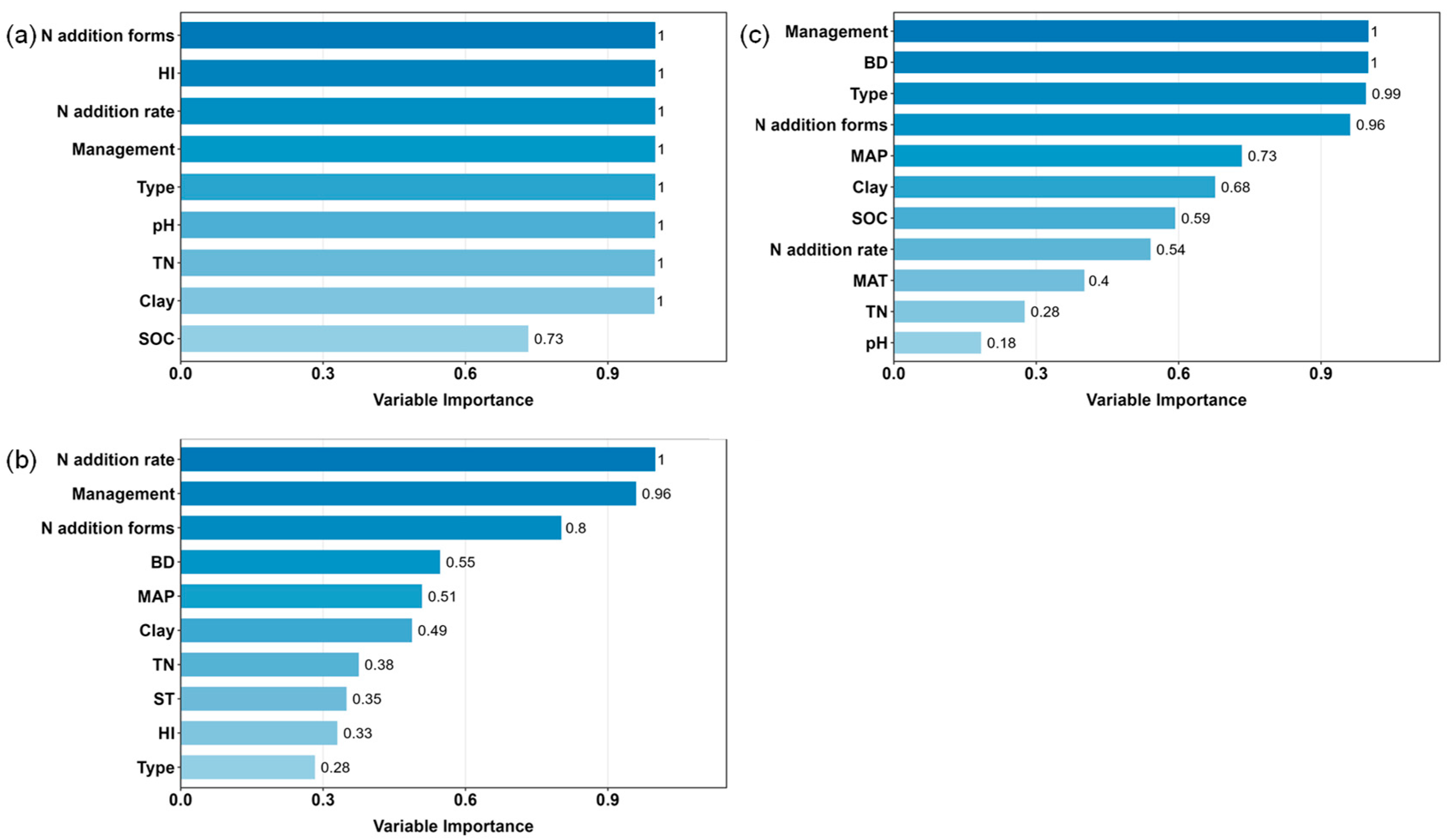Asymmetric Response of Grassland Greenhouse Gases to Nitrogen Addition: A Global Meta-Analysis
Abstract
1. Introduction
2. Materials and Methods
2.1. Data Compilation
2.2. Meta-Analysis Statistical Procedures
3. Results
3.1. Response of Grassland Soil GHG Fluxes to N Addition
3.2. Factors Driving the Response of Grassland Soil GHG Fluxes to N Addition
4. Discussion
5. Conclusions
Author Contributions
Funding
Data Availability Statement
Acknowledgments
Conflicts of Interest
References
- Bai, Y.; Cotrufo, M.F. Grassland soil carbon sequestration: Current understanding, challenges, and solutions. Science 2022, 377, 603–608. [Google Scholar] [CrossRef]
- Bardgett, R.D.; Bullock, J.M.; Lavorel, S.; Manning, P.; Schaffner, U.; Ostle, N.; Chomel, M.; Durigan, G.; Fry, E.L.; Johnson, D.; et al. Combatting global grassland degradation. Nat. Rev. Earth Environ. 2021, 2, 720–735. [Google Scholar] [CrossRef]
- O’Mara, F.P. The role of grasslands in food security and climate change. Ann. Bot. 2012, 110, 1263–1270. [Google Scholar] [CrossRef] [PubMed]
- Wilsey, B.J. The Biology of Grasslands; Oxford University Press: Oxford, UK, 2018. [Google Scholar]
- Liu, L.; Sayer, E.J.; Deng, M.; Li, P.; Liu, W.; Wang, X.; Yang, S.; Huang, J.; Luo, J.; Su, Y.; et al. The grassland carbon cycle: Mechanisms, responses to global changes, and potential contribution to carbon neutrality. Fundam. Res. 2023, 3, 209–218. [Google Scholar] [CrossRef] [PubMed]
- Dangal, S.R.S.; Tian, H.; Pan, S.; Zhang, L.; Xu, R. Greenhouse gas balance in global pasturelands and rangelands. Environ. Res. Lett. 2020, 15, 104006. [Google Scholar] [CrossRef]
- Risch, A.C.; Zimmermann, S.; Ochoa-Hueso, R.; Schütz, M.; Frey, B.; Firn, J.L.; Fay, P.A.; Hagedorn, F.; Borer, E.T.; Seabloom, E.W.; et al. Soil net nitrogen mineralisation across global grasslands. Nat. Commun. 2019, 10, 4981. [Google Scholar] [CrossRef]
- Lyu, X.; Li, X.; Wang, K.; Zhang, C.; Dang, D.; Dou, H.; Lou, A. Strengthening grassland carbon source and sink management to enhance its contribution to regional carbon neutrality. Ecol. Indic. 2023, 152, 110341. [Google Scholar] [CrossRef]
- Zhu, J.; Jia, Y.; Yu, G.; Wang, Q.; He, N.; Chen, Z.; He, H.; Zhu, X.; Li, P.; Zhang, F.; et al. Changing patterns of global nitrogen deposition driven by socio-economic development. Nat. Commun. 2025, 16, 46. [Google Scholar] [CrossRef]
- Reay, D.S.; Dentener, F.; Smith, P.; Grace, J.; Feely, R.A. Global nitrogen deposition and carbon sinks. Nat. Geosci. 2008, 1, 430–437. [Google Scholar] [CrossRef]
- Galloway, J.N.; Townsend, A.R.; Erisman, J.W.; Bekunda, M.; Cai, Z.; Freney, J.R.; Martinelli, L.A.; Seitzinger, S.P.; Sutton, M.A. Transformation of the Nitrogen Cycle: Recent Trends, Questions, and Potential Solutions. Science 2008, 320, 889–892. [Google Scholar] [CrossRef] [PubMed]
- Lü, X.; Li, K.; Song, L.; Liu, X. Impacts of Nitrogen Deposition on China’s Grassland Ecosystems. In Atmospheric Reactive Nitrogen in China: Emission, Deposition and Environmental Impacts; Liu, X., Du, E., Eds.; Springer: Singapore, 2020; pp. 215–243. [Google Scholar]
- Greaver, T.L.; Clark, C.M.; Compton, J.E.; Vallano, D.; Talhelm, A.F.; Weaver, C.P.; Band, L.E.; Baron, J.S.; Davidson, E.A.; Tague, C.L.; et al. Key ecological responses to nitrogen are altered by climate change. Nat. Clim. Change 2016, 6, 836–843. [Google Scholar] [CrossRef]
- Xu, Z.; Jiang, Y.; Zhou, G. Nitrogen cycles in terrestrial ecosystems: Climate change impacts and mitigation. Environ. Rev. 2016, 24, 132–143. [Google Scholar] [CrossRef]
- Ren, Y.M.; Zao, Y.X.Z.; Zhao, Y.; Su, R.; Yang, G.W.; Li, X.R.; Kang, J.R.; Shi, Y.Y.; Xie, Y.R.; Wang, N.N.; et al. Association between CH4 uptake and N2O emission in grassland depends on nitrogen inputs. J. Plant Ecol. 2024, 17, rtae078. [Google Scholar] [CrossRef]
- Boon, A.; Robinson, J.S.; Chadwick, D.R.; Cardenas, L.M. Effect of cattle urine addition on the surface emissions and subsurface concentrations of greenhouse gases in a UK peat grassland. Agric. Ecosyst. Environ. 2014, 186, 23–32. [Google Scholar] [CrossRef]
- Chen, J.H.; Zhang, Y.J.; Yang, Y.; Tao, T.T.; Sun, X.; Guo, P. Effects of increasing organic nitrogen inputs on CO2, CH4, and N2O fluxes in a temperate grassland. Environ. Pollut. 2021, 268, 115822. [Google Scholar] [CrossRef]
- Chen, S.; Hao, T.X.; Goulding, K.; Misselbrook, T.; Liu, X.J. Impact of 13-years of nitrogen addition on nitrous oxide and methane fluxes and ecosystem respiration in a temperate grassland. Environ. Pollut. 2019, 252, 675–681. [Google Scholar] [CrossRef]
- Zhang, L.H.; Hou, L.Y.; Guo, D.F.; Li, L.H.; Xu, X.F. Interactive impacts of nitrogen input and water amendment on growing season fluxes of CO2, CH4, and N2O in a semiarid grassland, Northern China. Sci. Total Environ. 2017, 578, 523–534. [Google Scholar] [CrossRef]
- Phillips, R.L.; Podrebarac, F. Net fluxes of CO2, but not N2O or CH4, are affected following agronomic-scale additions of urea to prairie and arable soils. Soil Biol. Biochem. 2009, 41, 2011–2013. [Google Scholar] [CrossRef]
- Wu, X.; Wang, F.F.; Li, T.; Fu, B.J.; Lv, Y.H.; Liu, G.H. Nitrogen additions increase N2O emissions but reduce soil respiration and CH4 uptake during freeze-thaw cycles in an alpine meadow. Geoderma 2020, 363, 114157. [Google Scholar] [CrossRef]
- Hu, Y.; Jiang, H.M.; Wang, F.L.; Xu, Z.H.; Chen, Y.C.; Ma, S.Q.; Yan, Y.; Lu, X.Y. Opposite responses of global warming potential to ammonium and nitrate addition in an alpine steppe soil from Northern Tibet. Glob. Ecol. Conserv. 2020, 23, e01115. [Google Scholar] [CrossRef]
- Li, K.H.; Gong, Y.M.; Song, W.; He, G.X.; Hu, Y.K.; Tian, C.Y.; Liu, X.J. Responses of CH4, CO2 and N2O fluxes to increasing nitrogen deposition in alpine grassland of the Tianshan Mountains. Chemosphere 2012, 88, 140–143. [Google Scholar] [CrossRef]
- Luo, C.Y.; Wang, S.P.; Zhang, L.R.; Wilkes, A.; Zhao, L.; Zhao, X.Q.; Xu, S.X.; Xu, B. CO2, CH4 and N2O fluxes in an alpine meadow on the Tibetan Plateau as affected by N-addition and grazing exclusion. Nutr. Cycl. Agroecosyst. 2020, 117, 29–42. [Google Scholar] [CrossRef]
- Wang, Z.; Xing, A.; Shen, H. Effects of nitrogen addition on the combined global warming potential of three major soil greenhouse gases: A global meta-analysis. Environ. Pollut. 2023, 334, 121848. [Google Scholar] [CrossRef]
- Deng, L.; Huang, C.B.; Kim, D.G.; Shangguan, Z.P.; Wang, K.B.; Song, X.Z.; Peng, C.H. Soil GHG fluxes are altered by N deposition: New data indicate lower N stimulation of the N2O flux and greater stimulation of the calculated C pools. Glob. Change Biol. 2020, 26, 2613–2629. [Google Scholar] [CrossRef]
- Zheng, X.; Liu, Q.; Ji, X.F.; Cao, M.M.; Zhang, Y.F.; Jiang, J. How do natural soil NH4+, NO3− and N2O interact in response to nitrogen input in different climatic zones? A global meta-analysis. Eur. J. Soil Sci. 2021, 72, 2231–2245. [Google Scholar] [CrossRef]
- Chen, J.Y.; Feng, M.Y.; Cui, Y.X.; Liu, G. The impacts of nitrogen addition on upland soil methane uptake: A global meta-analysis. Sci. Total Environ. 2021, 795, 148863. [Google Scholar] [CrossRef] [PubMed]
- Ma, L.; Yang, H.L.; Pan, Z.L.; Rong, Y.P. In situ measurements and meta-analysis reveal that land-use changes combined with low nitrogen application promote methane uptake by temperate grasslands in China. Sci. Total Environ. 2020, 706, 136048. [Google Scholar] [CrossRef] [PubMed]
- Du, Y.G.; Ke, X.; Li, J.M.; Wang, Y.Y.; Cao, G.M.; Guo, X.W.; Chen, K.L. Nitrogen deposition increases global grassland N2O emission rates steeply: A meta-analysis. CATENA 2021, 199, 105105. [Google Scholar] [CrossRef]
- Wu, J.J.; Cheng, X.L.; Xing, W.; Liu, G.H. Soil-atmosphere exchange of CH4 in response to nitrogen addition in diverse upland and wetland ecosystems: A meta-analysis. Soil Biol. Biochem. 2022, 164, 108467. [Google Scholar] [CrossRef]
- Peng, Y.F.; Wang, G.Q.; Li, F.; Yang, G.B.; Fang, K.; Liu, L.; Qin, S.Q.; Zhang, D.Y.; Zhou, G.Y.; Fang, H.J.; et al. Unimodal Response of Soil Methane Consumption to Increasing Nitrogen Additions. Environ. Sci. Technol. 2019, 53, 4150–4160. [Google Scholar] [CrossRef]
- Long, X.E.; Shen, J.P.; Wang, J.T.; Zhang, L.M.; Di, H.J.; He, J.Z. Contrasting response of two grassland soils to N addition and moisture levels: N2O emission and functional gene abundance. J. Soils Sediments 2017, 17, 384–392. [Google Scholar] [CrossRef]
- Ning, Q.; Gu, Q.; Shen, J.; Lv, X.; Yang, J.; Zhang, X.; He, J.; Huang, J.; Wang, H.; Xu, Z.; et al. Effects of nitrogen deposition rates and frequencies on the abundance of soil nitrogen-related functional genes in temperate grassland of northern China. J. Soils Sediments 2015, 15, 694–704. [Google Scholar] [CrossRef]
- Liu, Y.H.; Liu, Y.H.; Zhang, J.Q.; Dong, J.Y.; Ren, S.Y. The impact of global change factors on the functional genes of soil nitrogen and methane cycles in grassland ecosystems: A meta-analysis. Oecologia 2025, 207, 6. [Google Scholar] [CrossRef]
- Dai, Z.; Zhang, Y.; Li, Y.; Xiang, T.; Wang, F.; Peng, J.; Yang, S.; Cao, W. Nitrification regulates the responses of soil nitrous oxide emissions to nitrogen addition in China: A meta-analysis from a gene perspective. Environ. Sci. Process. Impacts 2025, 27, 2367–2378. [Google Scholar] [CrossRef]
- Verma, P.; Sagar, R. Soil respiration response to nitrogen fertilization experiment in tropical grassland. Ecol. Res. 2022, 37, 390–405. [Google Scholar] [CrossRef]
- Adams, D.C.; Gurevitch, J.; Rosenberg, M.S. Resampling tests for meta-analysis of ecological data. Ecology 1997, 78, 1277–1283. [Google Scholar] [CrossRef]
- Xu, B.; Gui, D.; Peng, H.; Huang, Y.; Sha, Z. Green manuring alters reactive N losses and N pools in arable soils: A meta-regression study. Sci. Total Environ. 2024, 934, 173256. [Google Scholar] [CrossRef]
- Du, E.; Terrer, C.; Pellegrini, A.F.A.; Ahlström, A.; van Lissa, C.J.; Zhao, X.; Xia, N.; Wu, X.; Jackson, R.B. Global patterns of terrestrial nitrogen and phosphorus limitation. Nat. Geosci. 2020, 13, 221–226. [Google Scholar] [CrossRef]
- You, L.C.; Ros, G.H.; Chen, Y.L.; Yang, X.; Cui, Z.L.; Liu, X.J.; Jiang, R.F.; Zhang, F.S.; de Vries, W. Global meta-analysis of terrestrial nitrous oxide emissions and associated functional genes under nitrogen addition. Soil Biol. Biochem. 2022, 165, 108523. [Google Scholar] [CrossRef]
- Guo, P.; Diao, J.; Zuo, T.; Zhao, H.; Kong, D.; Yang, L.; Miao, M. Heterogeneous responses of soil nitrous oxide emissions to nitrogen addition: A global meta-analysis. CATENA 2025, 254, 108923. [Google Scholar] [CrossRef]
- Guo, Y.; Dong, Y.; Peng, Q.; Li, Z.; He, Y.; Yan, Z.; Qin, S. Effects of nitrogen and water addition on N2O emissions in temperate grasslands, northern China. Appl. Soil Ecol. 2022, 177, 104548. [Google Scholar] [CrossRef]
- Diao, H.; Xu, W.; Wang, J.; Liang, W.; Gao, Y.; Pang, G.; Chen, Y.; Wang, J.; Huang, Y.; Hao, J.; et al. Precipitation increase enhanced the positive effect of nitrogen addition on soil N2O emissions by promoting soil nitrogen transformation and plant productivity in saline-alkaline grassland of Northern China. Agric. Water Manag. 2025, 314, 109509. [Google Scholar] [CrossRef]
- Qiu, Y.; Zhang, Y.; Zhang, K.; Xu, X.; Zhao, Y.; Bai, T.; Zhao, Y.; Wang, H.; Sheng, X.; Bloszies, S.; et al. Intermediate soil acidification induces highest nitrous oxide emissions. Nat. Commun. 2024, 15, 2695. [Google Scholar] [CrossRef]
- Blagodatskaya, E.; Zheng, X.; Blagodatsky, S.; Wiegl, R.; Dannenmann, M.; Butterbach-Bahl, K. Oxygen and substrate availability interactively control the temperature sensitivity of CO2 and N2O emission from soil. Biol. Fertil. Soils 2014, 50, 775–783. [Google Scholar] [CrossRef]
- Huang, X.; Liu, X.; Liao, L.; Li, J.; Luo, G.; Li, B.; Ma, Z.; Wang, Z. Grazing decreases carbon storage in the Qinghai-Tibet Plateau grasslands. Commun. Earth Environ. 2025, 6, 198. [Google Scholar] [CrossRef]
- Oenema, O.; Wrage, N.; Velthof, G.L.; van Groenigen, J.W.; Dolfing, J.; Kuikman, P.J. Trends in Global Nitrous Oxide Emissions from Animal Production Systems. Nutr. Cycl. Agroecosyst. 2005, 72, 51–65. [Google Scholar] [CrossRef]
- Tian, D.H.; Wang, H.; Sun, J.; Niu, S.L. Global evidence on nitrogen saturation of terrestrial ecosystem net primary productivity. Environ. Res. Lett. 2016, 11, 024012. [Google Scholar] [CrossRef]
- Liu, L.; Greaver, T.L. A global perspective on belowground carbon dynamics under nitrogen enrichment. Ecol. Lett. 2010, 13, 819–828. [Google Scholar] [CrossRef] [PubMed]
- Niu, G.; Hasi, M.; Wang, R.; Wang, Y.; Geng, Q.; Hu, S.; Xu, X.; Yang, J.; Wang, C.; Han, X.; et al. Soil microbial community responses to long-term nitrogen addition at different soil depths in a typical steppe. Appl. Soil Ecol. 2021, 167, 104054. [Google Scholar] [CrossRef]
- Huang, M.; Chen, X.; Degen, A.A.; Guo, R.; Zhang, T.; Luo, B.; Li, H.; Zhao, J.; Shang, Z. Nitrogen addition stimulated soil respiration more so than carbon addition in alpine meadows. Environ. Res. 2023, 233, 116501. [Google Scholar] [CrossRef]
- Kong, L.; Song, J.; Ru, J.; Feng, J.; Hou, J.; Wang, X.; Zhang, Q.; Wang, H.; Yue, X.; Zhou, Z.; et al. Nitrogen addition does not alter symmetric responses of soil respiration to changing precipitation in a semi-arid grassland. Sci. Total Environ. 2024, 921, 171170. [Google Scholar] [CrossRef] [PubMed]
- Wang, Y.; Luo, G.; Li, C.; Zhang, Y.; Zhang, C.; Yu, X.; Fan, B.; Zhang, W.; Xie, M.; Liu, Y. Grazing weakens the carbon sequestration capacity of dry temperate grassland ecosystems in Central Asia. CATENA 2025, 248, 108608. [Google Scholar] [CrossRef]
- Nwokolo, N.L.; Enebe, M.C. Methane production and oxidation–-A review on the pmoA and mcrA gene abundances for understanding the functional potentials of agricultural soils. Pedosphere 2025, 35, 161–181. [Google Scholar] [CrossRef]
- Bodelier, P.L.E.; Laanbroek, H.J. Nitrogen as a regulatory factor of methane oxidation in soils and sediments. FEMS Microbiol. Ecol. 2004, 47, 265–277. [Google Scholar] [CrossRef]
- Le Mer, J.; Roger, P. Production, oxidation, emission and consumption of methane by soils: A review. Eur. J. Soil Biol. 2001, 37, 25–50. [Google Scholar] [CrossRef]
- Hansen, L.V.; Brændholt, A.; Tariq, A.; Jensen, L.S.; Peixoto, L.E.K.; Petersen, S.O.; Bruun, S. Methane uptake rates across different soil types and agricultural management practices in Denmark. Agric. Ecosyst. Environ. 2024, 363, 108878. [Google Scholar] [CrossRef]
- Rafalska, A.; Walkiewicz, A.; Osborne, B.; Klumpp, K.; Bieganowski, A. Variation in methane uptake by grassland soils in the context of climate change—A review of effects and mechanisms. Sci. Total Environ. 2023, 871, 162127. [Google Scholar] [CrossRef] [PubMed]
- Lee, J.; Oh, Y.; Lee, S.T.; Seo, Y.O.; Yun, J.; Yang, Y.; Kim, J.; Zhuang, Q.; Kang, H. Soil organic carbon is a key determinant of CH4 sink in global forest soils. Nat. Commun. 2023, 14, 3110. [Google Scholar] [CrossRef] [PubMed]
- Wang, J.Y.; Chadwick, D.R.; Cheng, Y.; Yan, X.Y. Global analysis of agricultural soil denitrification in response to fertilizer nitrogen. Sci. Total Environ. 2018, 616, 908–917. [Google Scholar] [CrossRef]
- IPCC. Climate Change 2023: Synthesis Report; Contribution of Working Groups I, II and III to the Sixth Assessment Report of the Intergovernmental Panel on Climate Change; Core Writing Team, Lee, H., Romero, J., Eds.; IPCC: Geneva, Switzerland, 2023; pp. 35–115. [Google Scholar] [CrossRef]
- Taş, N.; de Jong, A.E.E.; Li, Y.; Trubl, G.; Xue, Y.; Dove, N.C. Metagenomic tools in microbial ecology research. Curr. Opin. Biotechnol. 2021, 67, 184–191. [Google Scholar] [CrossRef] [PubMed]
- Rousk, J.; Bengtson, P. Microbial regulation of global biogeochemical cycles. Front. Microbiol. 2014, 5, 103. [Google Scholar] [CrossRef] [PubMed]
- Greenlon, A.; Sieradzki, E.; Zablocki, O.; Koch, B.J.; Foley, M.M.; Kimbrel, J.A.; Hungate, B.A.; Blazewicz, S.J.; Nuccio, E.E.; Sun, C.L.; et al. Quantitative stable-isotope probing (qSIP) with metagenomics links microbial physiology and activity to soil moisture in Mediterranean-climate grassland ecosystems. bioRxiv 2022. [Google Scholar] [CrossRef] [PubMed]






| GHGs | Variable | Meta-Regression Results | |
|---|---|---|---|
| Qm | p Value | ||
| N2O | Type | 247.2 | <0.001 *** |
| Management | 394.44 | <0.001 *** | |
| N addition rate | 2393.51 | <0.001 *** | |
| N addition forms | 1436.3 | <0.001 *** | |
| MAP | 47.46 | <0.001 *** | |
| MAT | 49.66 | <0.001 *** | |
| pH | 88.08 | <0.001 *** | |
| SOC | 104.13 | <0.001 *** | |
| Clay | 74.6 | <0.001 *** | |
| HI | 65.97 | <0.001 *** | |
| CO2 | Type | 2.24 | 0.33 |
| Management | 23.66 | <0.001 *** | |
| N addition rate | 2,571,277.15 | <0.001 *** | |
| N addition forms | 13.67 | 0.01 ** | |
| MAP | 0.30 | 0.86 | |
| MAT | 1.99 | 0.37 | |
| pH | 3.34 | 0.19 | |
| SOC | 1.48 | 0.69 | |
| Clay | 0.50 | 0.78 | |
| HI | 24.89 | <0.001 *** | |
| CH4 | Type | 14.24 | <0.001 *** |
| Management | 92.29 | <0.001 *** | |
| N addition rate | 6.32 | 0.1 | |
| N addition forms | 19.03 | <0.001 *** | |
| MAP | 2.92 | 0.23 | |
| MAT | 28.35 | <0.001 *** | |
| pH | 3.03 | 0.22 | |
| SOC | 12.48 | 0.01 ** | |
| Clay | 3.09 | 0.21 | |
| HI | 13.20 | 0.01 * | |
Disclaimer/Publisher’s Note: The statements, opinions and data contained in all publications are solely those of the individual author(s) and contributor(s) and not of MDPI and/or the editor(s). MDPI and/or the editor(s) disclaim responsibility for any injury to people or property resulting from any ideas, methods, instructions or products referred to in the content. |
© 2025 by the authors. Licensee MDPI, Basel, Switzerland. This article is an open access article distributed under the terms and conditions of the Creative Commons Attribution (CC BY) license (https://creativecommons.org/licenses/by/4.0/).
Share and Cite
Cui, X.; Zhang, Y.; Song, X. Asymmetric Response of Grassland Greenhouse Gases to Nitrogen Addition: A Global Meta-Analysis. Agronomy 2025, 15, 2365. https://doi.org/10.3390/agronomy15102365
Cui X, Zhang Y, Song X. Asymmetric Response of Grassland Greenhouse Gases to Nitrogen Addition: A Global Meta-Analysis. Agronomy. 2025; 15(10):2365. https://doi.org/10.3390/agronomy15102365
Chicago/Turabian StyleCui, Xiaoqing, Yu Zhang, and Xiping Song. 2025. "Asymmetric Response of Grassland Greenhouse Gases to Nitrogen Addition: A Global Meta-Analysis" Agronomy 15, no. 10: 2365. https://doi.org/10.3390/agronomy15102365
APA StyleCui, X., Zhang, Y., & Song, X. (2025). Asymmetric Response of Grassland Greenhouse Gases to Nitrogen Addition: A Global Meta-Analysis. Agronomy, 15(10), 2365. https://doi.org/10.3390/agronomy15102365






